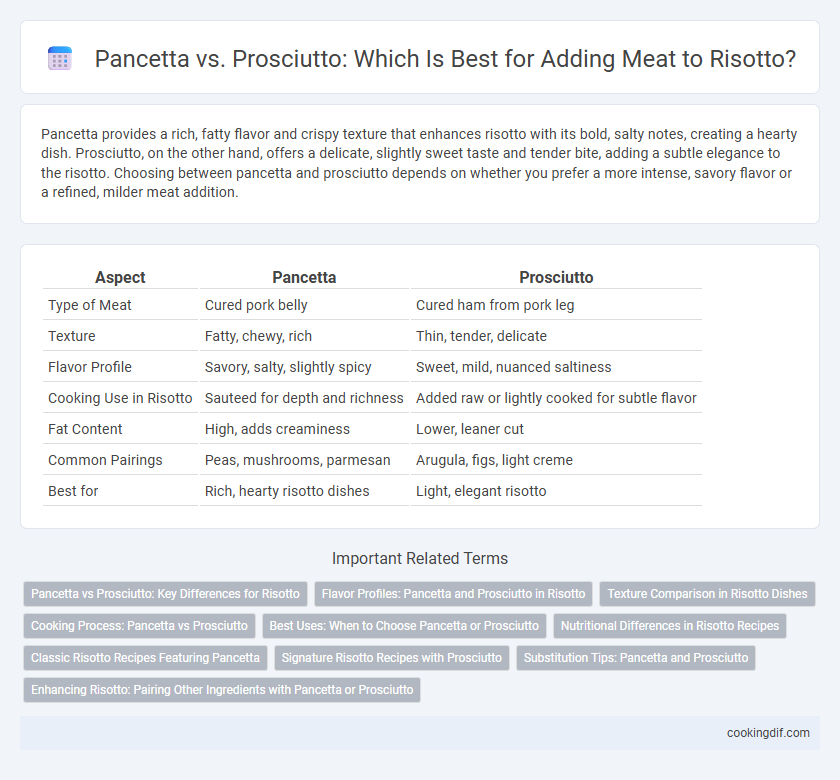Pancetta provides a rich, fatty flavor and crispy texture that enhances risotto with its bold, salty notes, creating a hearty dish. Prosciutto, on the other hand, offers a delicate, slightly sweet taste and tender bite, adding a subtle elegance to the risotto. Choosing between pancetta and prosciutto depends on whether you prefer a more intense, savory flavor or a refined, milder meat addition.
Table of Comparison
| Aspect | Pancetta | Prosciutto |
|---|---|---|
| Type of Meat | Cured pork belly | Cured ham from pork leg |
| Texture | Fatty, chewy, rich | Thin, tender, delicate |
| Flavor Profile | Savory, salty, slightly spicy | Sweet, mild, nuanced saltiness |
| Cooking Use in Risotto | Sauteed for depth and richness | Added raw or lightly cooked for subtle flavor |
| Fat Content | High, adds creaminess | Lower, leaner cut |
| Common Pairings | Peas, mushrooms, parmesan | Arugula, figs, light creme |
| Best for | Rich, hearty risotto dishes | Light, elegant risotto |
Pancetta vs Prosciutto: Key Differences for Risotto
Pancetta and prosciutto differ significantly in texture and flavor, impacting risotto's final taste and mouthfeel. Pancetta, a cured pork belly with a rich, fatty texture, imparts a savory, slightly spiced depth that melts smoothly into the creamy risotto, enhancing its richness. Prosciutto, a dry-cured ham, offers a leaner, saltier bite with a delicate aroma, often added as a finishing garnish to preserve its tender, silky texture without overpowering the dish.
Flavor Profiles: Pancetta and Prosciutto in Risotto
Pancetta infuses risotto with a rich, savory, and slightly spiced flavor due to its cured, unsmoked pork belly, adding a tender, fatty texture that melts into the creamy rice. Prosciutto offers a delicate, sweet, and salty profile with a more pronounced umami note from its dry-cured ham, imparting a subtle elegance without overpowering the dish. Choosing pancetta enhances the risotto's depth and robustness, while prosciutto provides a lighter, refined meatiness that complements rather than dominates the flavors.
Texture Comparison in Risotto Dishes
Pancetta offers a rich, fatty texture that crisps beautifully when cooked, creating a satisfying contrast in creamy risotto dishes. Prosciutto, with its delicate, thinly sliced form, imparts a tender, melt-in-the-mouth experience without overwhelming the risotto's smooth consistency. Choosing pancetta enhances the dish with crunchy, savory bites, while prosciutto provides a subtle, silky finish that blends seamlessly into the risotto.
Cooking Process: Pancetta vs Prosciutto
Pancetta is ideal for risotto as it renders fat slowly during cooking, infusing each grain with a rich, savory depth, while prosciutto, typically added towards the end, imparts a delicate, salty finish without extensive cooking. Pancetta's curing and fat content allow it to crisp up beautifully in the saute stage, creating a textured contrast that elevates the creamy risotto base. Prosciutto's thin, dry-cured slices offer a subtle aroma and tenderness that complement risotto when folded in off the heat, preserving its nuanced flavor.
Best Uses: When to Choose Pancetta or Prosciutto
Pancetta is ideal for risotto when a rich, savory depth is desired, as its fatty texture melts into the rice, enhancing creaminess and flavor complexity. Prosciutto works best when added at the end or as a garnish to preserve its delicate, salty taste and tender texture, providing a subtle contrast without overpowering the dish. Choose pancetta for a cooked, hearty flavor profile and prosciutto for a lighter, nuanced finish in risotto recipes.
Nutritional Differences in Risotto Recipes
Pancetta contains higher fat content and calories compared to prosciutto, making it richer but heavier for risotto recipes. Prosciutto offers a lower fat and protein-rich option, contributing flavor with less caloric impact. Selecting between pancetta and prosciutto affects macronutrient balance and overall taste profile in risotto dishes.
Classic Risotto Recipes Featuring Pancetta
Classic risotto recipes frequently feature pancetta for its rich, savory flavor and crispy texture, which enhances the creamy arborio rice base without overpowering it. Unlike prosciutto, which is cured and softer with a delicate taste, pancetta is cured but uncooked, allowing it to render fat and infuse the risotto with a deep, smoky essence. Incorporating pancetta in risotto supports traditional Italian culinary techniques, balancing umami and maintaining an optimal texture contrast in every bite.
Signature Risotto Recipes with Prosciutto
Signature risotto recipes with prosciutto elevate the dish by adding a delicate, savory flavor and a tender texture that complements creamy Arborio rice. Unlike pancetta, which offers a smoky, crispy bite, prosciutto imparts a refined, melt-in-your-mouth richness that enhances the umami profile without overpowering saffron, mushroom, or parmesan-based risottos. Using thinly sliced prosciutto folded into the risotto just before serving preserves its silky quality and balances the dish's creaminess with subtle saltiness.
Substitution Tips: Pancetta and Prosciutto
Pancetta and prosciutto both add distinct savory flavors to risotto, with pancetta offering a rich, fatty profile and prosciutto delivering a delicate, slightly sweet taste. When substituting pancetta for prosciutto, use slightly less salt and render it slowly for a crisp texture that enhances the risotto's creaminess. For prosciutto as a pancetta alternative, add it at the end to preserve its tender texture and subtle flavor, complementing delicate risotto ingredients like peas or asparagus.
Enhancing Risotto: Pairing Other Ingredients with Pancetta or Prosciutto
Pancetta offers a rich, savory depth with its fatty, cured pork flavor, making it ideal for creating a creamy, hearty risotto base. Prosciutto provides a delicate, salty finish that complements lighter risotto varieties with vegetables or seafood. Both meats enhance umami profiles, but pancetta adds a robust texture, while prosciutto lends elegance and subtle sweetness to the dish.
Pancetta vs Prosciutto for meat addition Infographic

 cookingdif.com
cookingdif.com